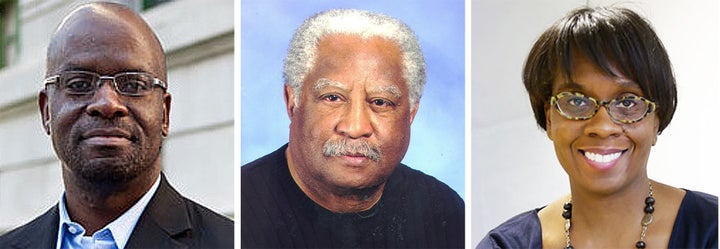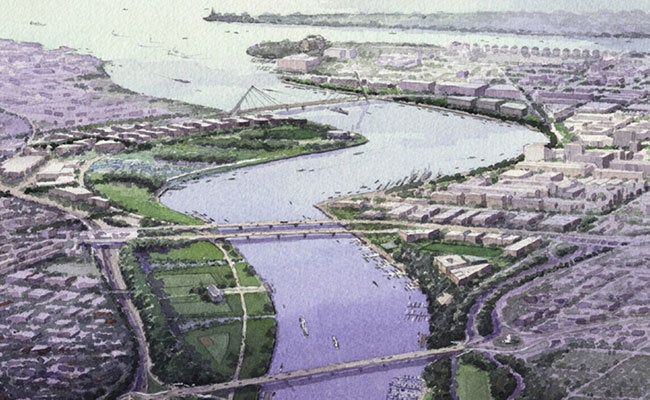Washington, DC, could become the center of a different dialogue about architecture. (The third in a series of articles centered on the National Museum of African American History and Culture.)

View of the National Mall from across the Potomac River, with the new National Museum of African American History and Culture to the left of the Washington Monument.
What are the earmarks of serious architectural criticism?
Last year, I posed that question to ten noted design journalists (“The 7 Lamps of Architecture Criticism,” Huffington Post). With five men and five women spanning a variety of ages and locations, the group seemed a healthy representation of diversity in the field, although admittedly there was only one person of color. Responding to a montage of their photos, a reader asked, “So architecture criticism is white?”
Sadly, yes. Few minorities ever have been professionally employed as design critics or journalists. For example, since 1963, when Ada Louise Huxtable became the first full-time architecture critic for a major newspaper, there has been only one African American in that position—Lee Bey, at the Chicago Sun-Times (1996-2001). “I was the first, the last, the only,” he told me recently. (Chuck Berry’s reaction when he met Bey: “A Black architecture critic? Get down!”) Blacks make up 13% of the American public but only 2% of American architects and, in the past fifty years, apparently only one professional critic. Google the phrase “African American architecture critic” (or “criticism”), and nothing comes up. Billions of pages on the internet, not one hit. Evidently the topic doesn’t exist.
Of course, the relationships between Black culture and architecture have been explored, but the topic deserves far more attention. The new National Museum of African American History and Culture (NMAAHC), given its subject matter and a world-class building, could make this happen. In fact, Washington, DC, is poised to become the center of the conversation.
Historically, the capital city always has had one of the country’s largest African American populations and consequently has been a center of Black culture and history. Currently, over half the population is Black, making it the district or state with the highest percentage by far. Washington and nearby Baltimore are both in the top ten cities with the largest percentages, and a 2010 review showed that DC has the country’s largest number of architects per capita. Comparing that list to the Directory of African American Architects reveals that they could account for 21% of resident architects in DC—ten times the national average. The National Organization of Minority Architects (NOMA) is headquartered here, and two of the thirteen architecture programs at historically Black colleges and universities (HBCUs) are in Washington—the University of the District of Columbia and Howard University, which ranks in the top 25% of all architecture schools. A third, Morgan State, is in Baltimore. Melvin Mitchell, who has taught in all three schools, calls the DC area “the center of the Black architectural universe.”

LEFT TO RIGHT: Lee Bey, Melvin Mitchell, Toni Griffin.
In his book, The Crisis of the African-American Architect (2003), Mitchell, an architect who has practiced in the DC area for 50 years, writes that “Black America, with a gross national product equal to the 10th largest economy on earth, is woefully under-served architecturally.” How? “[I]t would appear that architecture is only signature buildings, and signature buildings are commissioned by powerful white institutions and individuals and designed virtually exclusively by white architects.” Who’s to blame? Architecture critics, in part. “Adulation is heaped upon the usual suspect collection of ‘star’ white architects by the New York-centered self-anointed high priests of so-called avant-garde defining critics.” The fact that Black culture has been virtually absent from the dialogue is precisely what prompted Mitchell to write his book fifteen years ago—to call attention to the void.
At the time, Mitchell tells me now, “many felt that African American culture has nothing to do with architecture. Since the founding of the USA the word ‘architecture’ has been ‘white architecture’ by default.” What’s missing from the public discourse as a result of this underrepresentation? “So much I can hardly articulate it all,” says Lee Bey. “Generally, what’s being written about is gentrification. When people write that a city has ‘come back,’ they only mean certain neighborhoods. What’s missing is a perspective, the way Black people see the city. What’s happening on the street corner makes a community. It’s personal. When the local barbershop goes away, the community dies a little. A sense of place disappears.” Bey’s writing generally has focused on transit issues, preservation, and “the politics of how things get built.”
Twenty-five years ago, in an essay titled “Race and Architecture,” Cornell West excoriated contemporary architecture critics for their reluctance to engage in a serious analysis of how architecture is controlled by corporate and political authorities. The future of criticism, he insisted, would rely on a greater willingness to address “the current cultural crisis as it shapes and is shaped by architectural practices.” As Mitchell put it in his book, “There is no one available to act as intermediaries in today's Black America.”
“The crucial responsibility of a black architect to Black America,” writes Mitchell, “is to envision and conceptualize productive new environments, create value, and deliberately reflect African-American culture where none of those things currently exists.” In a nutshell, this is the task of African American architecture criticism, as Mitchell makes clear: “An architecture which places black economic, social, political and cultural interest ahead of personal quests for white mainstream recognition will have to develop its own standards of excellence, valorize itself, and engage openly in continuous published polemical writing and dialogues as well as scholarly research.” In a powerful call to action, Mitchell demands that American architects embrace “a bold and inclusive ‘New (Black) Urbanism.’”

Anacostia Waterfront Framework Plan (2003).
Segregation has barred many cities, including Washington, from gaining a more inclusive urbanism, says Toni Griffin. She is the founding Director of the J. Max Bond Center, dedicated to “positive impact on urban reform” and named for the late architect who was instrumental in the design of the NMAAHC. Segregated cities create what Griffin calls “environments of social and spatial injustice.” The opposite, “urban justice,” promotes equitable, healthy conditions for everyone, regardless of race. She outlines ten principles of a “Just City" that embrace equity, diversity, and inclusion. For example, Griffin worked on the redevelopment of the Washington’s Anacostia Waterfront to redirect growth in a way that would benefit all Washingtonians.
The NMAAHC is bringing significant new attention not only to African American history and culture but also to African American architects and Washington, DC. The museum’s mission is to “tell the American story through the lens of African American history and culture,” and architecture is an essential aspect of that story. Yet, while Blacks are among the strongest voices in the history of every other area of American culture, architecture “has been one of those areas that Black people haven’t had much of a stamp on,” says Bey. “I hope [the new museum] opens a door not just for one Black starchitect [David Adjaye, lead designer of the NMAAHC] but for other people of color to play in this realm.”
In the Guardian in September, Steven Thrasher asked whether the “Black experience” needs such validation: “to require a building of such grandeur with a tony address, is quite at odds with the current political moment.” But the “political moment” has changed significantly in the past three months, and, with a controversial new presidential administration coming to power, the time is ripe for what Mitchell calls “an aggressive Black presence in and full command of the forces necessary to make architecture.”
